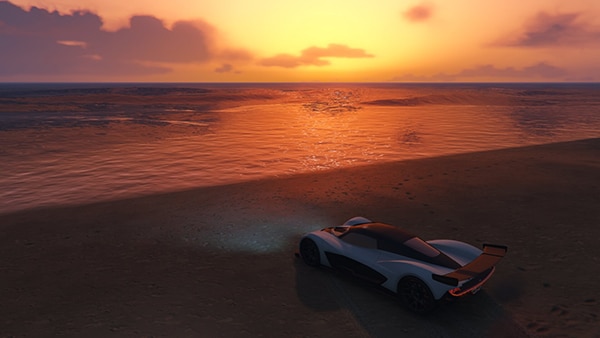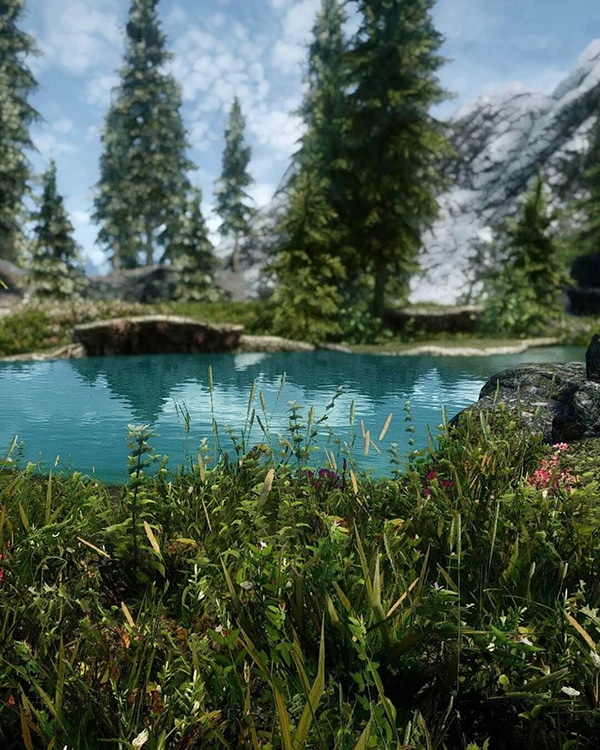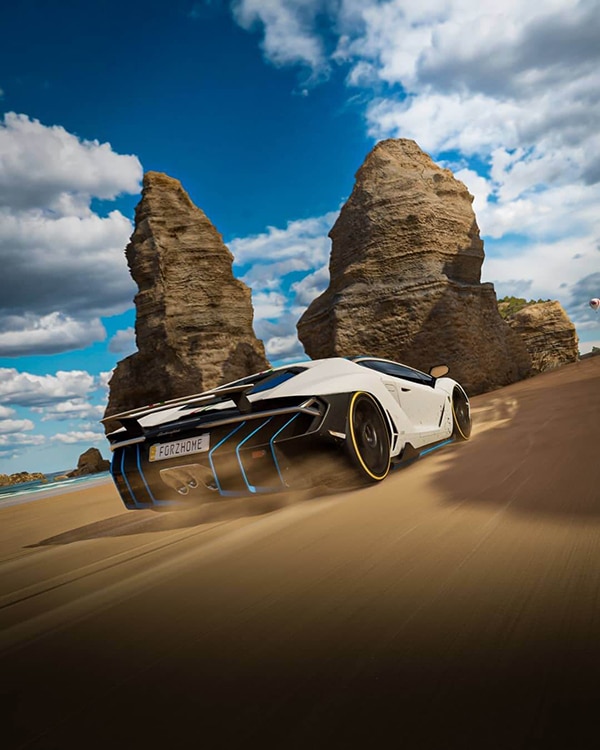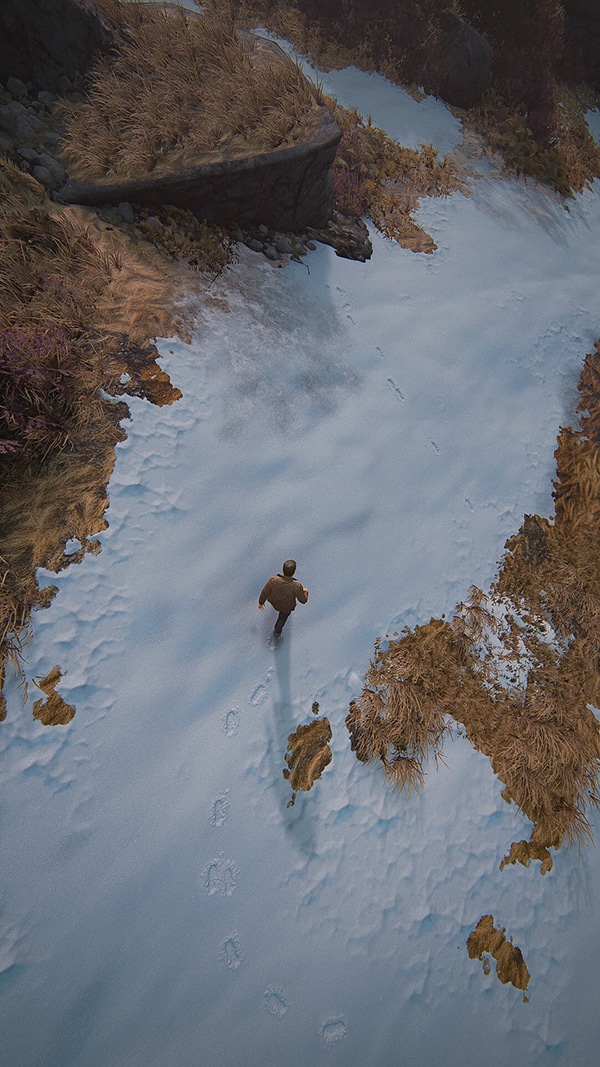
Virtual Photography Guide (+ Most Popular Video Games)
Learn everything you need to know about virtual photography and explore the 10 most popular video games for in-game photo captures.
Learn | By Judyth Satyn
This guide to video game photography (virtual photography) will open up a new world of photographic possibilities.
The virtual gaming visual graphics have advanced to impressive, sophisticated levels of realism.
A new generation of creatives are pioneering ways to capture striking visuals from the virtual realm.
Read on to learn how to transfer your real-life photography skills to take awe-inspiring photos of virtual life.
Table of Contents
What is Video Game Photography?
Video game photography is also referred to as “virtual photography” or “in-game photography”.
It is one of the most recent developments in photography. The art of capturing scenes from within a video game as it is being played.
The visuals in virtual worlds are so enticing players want to capture them. They range from fantastical settings to hyper-realistic environments.
Players use in-game cameras or photo modes to capture memorable and spectacular moments.
Today, many modern video games have dedicated camera modes. They are incorporated into the game to allow players greater control of their photo results.
This has led to a huge surge in the interest in virtual photography and in the quality of results.
In-game cameras allow players to adjust settings, change perspective, and alter focus. Often with settings just like a real-life camera.
Camera modes have features like free camera movement, filters, and depth-of-field control.
Similarly to traditional photography, in-game photographers can use post-processing to fine-tune their images.
This includes enhancing color, cropping, or adding special effects.

Credit: Tima Miroshnichenko
The early years of video games are remembered fondly for their basic graphics and pixelation.
70’s games such as Pong and Space Invaders lacked in-game camera tools, and there was no such thing as a screenshot.
The introduction of 8-bit and 16-bit gaming consoles in the 80s improved games’ visual graphics.
In the 90’s, games experimented with basic camera mechanics. However, video game photography was not a significant feature.
The photography games available were based on the mechanics of taking photos. The camera was not used to capture an image but was a way to progress in the game.
Video game visuals became increasingly impressive, making players more keen to capture their experiences.
Innovative players hacked code or used screen capture tools to snap images. However, the level of control was lacking, and the ability to compose was limited.
How Much Do You REALLY Know About Photography?! 🤔
Test your photography knowledge with this quick quiz!
See how much you really know about photography...

Players also used external software to capture higher-resolution images. This gave them more control over the final result.
Developers worked to integrate innovative photo modes into the virtual gaming world.
In 2005, Gran Turismo 4 was the first game to include a dedicated photo mode. This allowed complete control of a camera and included filters.
It was specifically for use to share or remember, not as part of the gaming quest.
This kickstarted the rise of shared in-game experiences on social media outside of the game space.
The popularity of photo modes has grown, and it is now something players look for in a game. However, not every game needs a camera mode.
Surprisingly, some of the most visually striking games don’t have a photo mode.
In 2016, Nvidia released a software development kit called Ansel designed to simplify virtual photography.
This Nvidia kit includes many impressive features, including 360-degree photographs. 360 photographs can be viewed online using Google Cardboard.
These recent developments take photography to a whole new level. In-game photography has added a completely new dimension to traditional photography.
And this is only the beginning. Who knows where it will take us next?
Is video game photography a job?
Yes and no, video game photography is similar to other genres of photography. It doesn’t have to be a job, but it can be.
If you are crazy about photography and gaming, you can combine the two and have your ultimate job.
There are photography job opportunities in the virtual gaming world for skilled in-game photographers.
The majority of virtual photography work is promotional and marketing game photography.
These photographers are responsible for shooting promotional material for video games.
This can include content creation for social media to generate interest and attract new fans.
Virtual photographers can sell their photographs as artworks, limited editions, or digital prints.
As a new photography genre, it is not as widely recognized as other professional photography genres.
In-game tutorials and journalism are two other career paths that video game photographers can consider.
Online game review sites require photos to enhance articles. Some of the top review sites are GamesRadar+, Metacritic and Destructoid.
So if you want to generate an income from your virtual world photography, it is possible.
Dedicate time to mastering virtual photography techniques and taking unique, captivating photographs.
Then you, too, could be a virtual photographer.
10 Most Popular Video Games for Virtual Photography
To find out which are the most popular video games for virtual photography, we conducted some research to measure the Instagram presence of the 100 most popular games from the last decade.

1. Red Dead Redemption 2
Taking the number one spot is Red Dead Redemption 2 by Rockstar Games, released in October 2018. RDR 2’s historic Wild West landscapes, teeming wildlife and protagonist Arthur Morgan have made an impressive mark on the photography community — attracting 165,000 photography posts since its release.
Consoles: PS4, XBox One, Google Stadia, PC



2. GTA 5
Second on our list is Grand Theft Auto 5, another Rockstar Games title. GTA raked in a total of 146,495 photography posts.
No surprises there! Like Red Dead, the complete freedom GTA gives players makes it the perfect playground for keen but restricted photographers.
Not got access to props like golden beaches, gorgeous sunsets, Bugattis, tanks, jet fighters, or Lamborghinis? Never fear; Los Santos has you covered.
Consoles: PS3, PS4, Xbox 360, XBox 1, PC


3. Fortnite
Fortnite comes third place with an impressive 135,007 photography posts. Fortnite is not just the world’s favourite Battle Royale. The game also offers a treasure trove of completely unrealistic but stunning photo ops such as the game’s range of colourful character skins and unusual architecture.
Consoles: PS4, XBox 1, Nintendo Switch, PC


4. Skyrim
Despite being one of the oldest games on the list, Skyrim from the Elder Scrolls franchise takes a proud fourth spot, with 46,208 photography posts since its release on the 11th of November 2011.
The game’s humongous open world, consisting of eerie dark forests, even eerier caves, and beautiful greenery surrounding vast mountains and icy glaciers, is likely to attract environmental photographers everywhere.
Consoles: XBox 360, XBox One, PS3, PS5, nintendo switch

5. Horizon Zero Dawn
In fifth place is Horizon Zero Dawn. There are a couple of reasons why this post-apocalyptic game is so befitting for virtual photography. First is the stunning detail given to protagonist Aloy.
Second is the excitement that comes with trying to take the perfect photo: in Horizon Zero Dawn, there’s always an underlying sense of danger as you sneak around this wild robot-infested world.
Finding the perfect shot is always accompanied by a shot of adrenaline.
Consoles: PS4, PC, XBox One

6. Forza Horizon 4
Sixth is Forza Horizon 4, part of XBox’s exclusive Forza series, which mopped up 33,144 posts.
The developers of this series have always created fire-looking games, and Horizon 4 is no exception. As you can see below, even the older-looking cars in this game are just as aesthetic as the surrounding landscapes.
Console: XBox One


7. Ghost of Tsushima
Ghost of Tsushima takes seventh place with 16,930 posts since its recent release on the 17th of July 2020. Not bad at all!
Your character, an ancient Samurai warrior, has a mystical presence which makes for some mesmerizing third-person shots on the Southeast Asian archipelago island Tsushima.
Console: Playstation 4

8. The Last of Us Part 2
In eighth place is The Last of Us 2 — which was only just released in June 2020 — making it the second most recent release on our list, behind Ghost of Tsushima.
The game has already racked up a considerable 9,912 posts.
Like many up-and-coming games, Last of Us 2 has a comprehensive photo mode with lots of settings to match the emotional depth of the game.

9. Uncharted 4
4,918 posts were given to Uncharted 4: A Thief’s End, taking it to ninth place.
Uncharted 4 has a photo mode that allows you to pause the game and tinker around with depth of field, motion blur, film grain, and a variety of filters, making it a popular game for virtual photographers.
Console: PS4

10. The Sims 4
The Sims 4 is a game you wouldn’t expect to see side-by-side with Ghost of Tsushima and Skyrim.
Yet, the game still made it onto the list with 5,339 photography posts.
Unlike other contenders on our list, The Sims isn’t the most stunning game in the world but it is certainly one of the most accessible, with an easy-to-use photo mode that allows you to take model pictures of your ‘Sim’ in all kinds of strange outfits and weird situations.
Consoles: XBox One, PS4, PC

Methodology:
To calculate the popularity of a game for virtual photography, we counted the number of photo posts on the top-performing photography hashtag for each game.
There were 2 main hashtag variations which pulled the most relevant results: #{videogame}photography and #{videogame}photomode
We counted posts for the top 100 most popular video games in the last 10 years according to Gamezo.co.uk
Red Dead Redemption 1 was excluded from the study because #reddeadredemptionphotography included photos of RDR 2 as well, making it an unfair estimation of RDR 1’s popularity.
Tools and Techniques for Video Game Photography

Credit: Yan Krukau
Capturing images in a virtual world presents a new set of technical challenges. Related to in-game camera controls, rendering limitations, and graphics settings.
Virtual photography continues to evolve as software developers offer increasingly sophisticated tools.
In recent years, game developers have incorporated in-game camera tools. This makes in-game photography easily accessible to all gamers.
Not only can they use a camera, but now they have settings similar to traditional cameras. This allows players to tweak shots to total perfection.
Using advanced photo mode, players can pause to examine the masterful in-game environments.
Using these in-game tools, players can create epic works of art. Art that boasts stunning environments, interesting compositions and intense visual effects.
This has led to a deeper appreciation of the creative ingenuity needed to create games. Plus, a desire to freeze scenes as memories.
In the early days of virtual photography, players would capture screenshots to create game photos.
Today, players are happily spoilt with high-tech tools and ever-evolving virtual photographic techniques.
In-Game Camera Tools
In-game camera tools are also known as “camera modes” or “photo modes”.
They make it possible to change the camera’s function in-game and give the player more control over their shots.
Photo modes are increasingly common as the demand for virtual photography grows.
Free camera control: When using free camera control, the camera can be detached from the character and moved independently around the scene. This increases the options for diverse compositions and creativity. It also allows players to take shots of their character in action.
Camera positioning: Camera positioning in photo mode allows the player control over the camera’s location. The player can adjust the camera’s angle, orientation and tilt. They can also set the camera to different heights and distances around the scene. Some games offer a drone-style camera that can shoot from 360-degree angles. Using camera positioning, players can take photos that would not be possible under real-life circumstances. However, it is worth noting that most consoles limit players to short-range cameras.
Zoom and focus: Players can zoom their camera in and out from the subject using camera mode. This allows players to capture close-up shots of characters’ expressions or zoom out to focus on the entire scene.
Depth of field: Depth of field can be altered using photo modes to create a shallow or wide depth of field. Artistic out-of-focus backgrounds can be generated similar to the bokeh effect. This allows players to get creative and decide which areas to focus the viewer’s eye on.
Time control: Time control mode allows players to pause the game to achieve the best angle for a shot. Some players use this to capture action shots. A scene can be frozen when the character is in the middle of a battle. A player can then take their time to choose the best camera settings and position for the ultimate shot.
Filters and effects: Games provide in-game filters and effects to enhance images. This gives players the option to add additional creative finesse. Popular filters include vintage, black and white, sepia and color tinting. Effects include blur, film grain, lens flare, and vignette, to name a few. One of my favourites is the comic book effect. You can use it to create stylized comic pages of your in-game experiences.
Character and object positioning: Character and object positioning isn’t an in-game camera mode. However, players use different techniques to reposition games where they want them. By interacting with characters, you can lead them into the position you want for your shot. Objects can be moved to create a more visually pleasing or interesting composition.
Weather and lighting: Photo modes allow players to change the time of day, adapt lighting and even adjust the direction of the wind. Players will alter the weather and lighting to generate their desired atmosphere and mood.
Replay and Rewind: Almost everything about photo modes is awesome, but this is extra special. Replay and rewind gives players the option to rewind to capture the highlights of their game. This is great for players who want to be fully immersed in a game but also want the option to capture the climax of a fight.
Save and share: When a player has created an art piece that the world just has to see. They can save or share directly to social media from the game.

Credit: Yan Krukau
There are many rad games to try if you want to try camera modes to create phenomenal in-game shots.
Some of the most popular games with camera modes are Red Dead Redemption, Ghost of Tsushima, and No Mans’s Sky.
Other fantabulous games to check out are Cyberpunk 2077, Spiderman, Grand Theft V, and Assasin’s Creed.
And you are bound to find many more.
Composition and Framing
You can transfer composition tricks and techniques from real-world photography to virtual photography.
It might be hard to take appealing images in an unfamiliar terrain at first.
Take some time to be a game tourist and familiarize yourself with the game’s aesthetics.
You will be more able to compose striking images when you are familiar with the game’s aesthetics.
Virtual photographers don’t just take random shots and hope for the best.
They usually take time to compose shots to create the most visually appealing images.
Some player’s aim is to capture the essence of their gaming experience to share.
When composing images, you can use classic composition techniques like the rule of thirds, leading lines and framing.
This will help direct the viewer’s gaze to the point of interest and balance the scene.
The central subject can be framed using game elements, such as a view through a doorway or the legs of a giant.
In Final Fantasy 16, elements such as forest branches are often used to frame characters.
Games are so dynamic there is no shortage of intriguing subject matter to compose.
Try and match the game’s theme; if it is a thriller game, create gruesome, horrific compositions.

Credit: Cottonbro Studio
When playing Super Mario 3D World, the compositions will be cheerful, bright and playful.
Pause games mid-action to find the perfect camera angle placement by using the rule of thirds.
You can escalate the drama of a photo composition with the use of unusual camera angles.
Take a low-angle shot to further exaggerate the size of a warrior. Or take a close-up image to amplify intimacy.
Games have incredible detail, which encourages players to return and revisit levels many times.
Particularly if you have free-roam gameplay, which allows you to explore every corner.
Some games are designed with photography in mind. A scene will be created by developers to be so stunning players will want to capture it.
The only issue with this is that everyone who finds themselves in this scene will take the same photo.
So, if you want to compose unique in-game photos, look for the off-route scenes.
Depth of Field Manipulation
You wouldn’t be blamed for assuming that virtual photography would be limited.
That the results would be pixilated and unrefined, and there is no option for bokeh.
You will be pleasantly surprised to find out that not only do game photos have the depth of field, but you can alter it.
This is one of the photo modes I appreciate in gaming photography. Creating a shallow depth of field can draw a character out from a distracting background.
At the same time, some scenes look the most visually compelling when all objects are in focus.
The depth of field can be set at the start of a game and adjusted when taking shots.
When the game is paused, use photo mode to experiment with different depths of fields.
Create a blurred background or foreground. Use the bokeh effect just like you would when shooting real-life photography.
Or, if you prefer, keep everything in focus.
Lighting Adjustments
When playing games, the lighting generally changes as the game progresses.
Night turns to day. A lamp light is lit, or a fire subsides.
You can use the in-game time lighting to generate different atmospheric moods.
Experienced virtual photographers use all aspects of a game to create a desired look.
When in-game, you can experiment with lighting sources for different effects.
Elements such as fire bombs or flashlights can be used to add dramatic light to a scene.
Luminous weapons can all be used strategically to adapt the scene’s lighting.
See if you can cast moody shadows on the walls. Or enter dark spaces and illuminate faces with hand-held candles.
Character and NPC Positioning
Virtual photographers intentionally interact with in-game characters to position them. They do this to stage dynamic or candid shots.
It is possible to evoke actions for poses using a creative level of in-game manipulation.
Some games have the option to pause and rewind to achieve the correct positioning.
Matching a character’s facial expressions to their action will add a sense of realism to a photo.
Jin of Ghost of Tsushima has 14 different facial expressions to choose from.
If a character is fighting, switch their expression to anger. When they are walking, you can switch it to calm.
Usually, it is only possible to change the expression of the main characters and not the NPC.
Tweaking expressions and positions is a great way to generate a richer representation of your virtual experience.
Filters and Effects
The visuals of open-world games are often so impressive that filters aren’t necessary.
But you can jazz up images and add a distinctive touch using post-processing effects.
Many games have in-game filters and effects which you can apply to your photos.
The Last Part of Us Part 2 allows players to add filters such as vignettes and film grain.
The time of day can be adjusted in-game and used to refine the lighting for photos.
These options allow players to change a photo’s mood or make a heavily stylized piece.
Ghost of Tsushima enables players to add a wide range of effects, including their famous cinematic black-and-white filter.
Red Dead Redemption 2 sports a vintage and sepia filter. Using it, players can give their photos an extra nostalgic Wild West feel.
Using post-production effects, you can enhance colors, add grain, or create vintage looks.
And remember, a good photo isn’t always about what looks most realistic.
Multiple Angle Captures
One incredible feature of virtual photography is the liberating freedom of camera position.
The camera is not confined to the view of the main character but can move freely around the scene.
This opens a huge scope of possibilities for angels and perspectives.
Take advantage of free camera modes to capture scenes from all possible angles.
You can capture bird’s-eye views or low-ground perspectives using photo mode’s diverse camera angles.
You can soar high over a character to capture the entire setting. There is usually a limitation on how far you can zoom out.
It’s worth noting, but seriously, who’s complaining? After all, when can you make your camera fly over a scene in real life?
Another issue is it is not always possible to get super close-up shots.
So, forget to pursue virtual macro photography as a career, at least for now.
There may be some limitations depending on which game you are using. Not all games offer extensive camera range.
Layered Shots
Layering and making composite images in photo editing software is popular with players.
Due to game restrictions, a photographer might not be able to compose the scene they want in the game.
Creating composites from layers allows for more creative input from the player.
Post-production, characters can be added to different backgrounds. Additional effects can be added to escalate the narrative.
The player has complete control to realise their fantasy and creative vision.
The image below is a composite of three Spidermans, an interesting composite using the same character.

Credit: Png.wm
Action and Freeze Frames
In the beginning, game programming didn’t allow a player to pause mid-action.
When a screenshot was taken of the virtual environment, there was no option to compose.
Instead, players captured random moments as and when they could.
Now, many games allow players to pause, rewind and replay scenes.
A player can freeze moments that you want to photograph and relish.
This adds a whole new dimension and freedom to virtual game photography.
Making it possible to capture dynamic events, like explosions, character jumps, or combat moves.
The option to compose action adventures likens in-game photography to staged photo shoots.
Who doesn’t want to capture an action shot when they defeat the bear of the blue waters in Assassin’s Creed?
And how ace will it be to share this stunning action pic of your triumph?
Freezing an action shot is all swell and good, but you might be surprised to hear it’s not that simple.
Action shots require skill and technique. It’s true. You can freeze the game mid-action and get your breathtaking photo.
But what happens when you unfreeze? You will need to be ready to jump straight back into action. Or it’s bye-bye to your character.
But don’t let that stop you. Use pause one of your favourite action-packed sequences at the right moment to capture a spell-binding shot.
Environment Interaction
Interacting with the game environment is how players can create dynamically composed photos.
In Ghost of Tsushima, you can trigger weather effects. This can be used to generate moody or atmospheric shots.
Weather conditions, from snow to wind, sunny to cloudy, can be implemented.
Adding fog effects can give the visuals a sense of depth and layering.
You can even alter the direction and speed of the wind to get the effect you are looking for.
Particles, such as leaves, pollen or debris, can be added to the scene to be blown by the wind.
In some games, ripples can be added to water to create richer textured environments.
Don’t be shy to set objects on fire to add interesting environmental effects or convey drama.
Third-Party Software
Players have used external software for decades to help capture high-resolution screenshots.
This is especially true when the in-game photography tools are limited. After all, not all games have photo mode.
There is some impressive third-party software on the market worth knowing about.
These can be used to capture images in one of the strikingly visual games that don’t have photo mode.
Which includes games such as The Witcher 3 Wild Hunt, Sky Rim or Fall Out 4.
NVIDIA Ansel is a popular in-game photography tool. It will give you extensive camera controls, including free camera movement.
Do you want to be a virtual photographer trailblazer? Use NVIDIA tools to capture images in Mass Effect: Andromeda.
You can use NVIDIA’s post-processing effects to fine-tune your images.
Hattiwatti’s Cinematic Tools provides camera mode and other features to capture in-game photos.
ReShade doesn’t offer in-game camera controls but is popular for enhancing post-production graphics.
Tutorials and Community Insights
If you get hooked on virtual photography, you will be happy to know there are many online communities.
These communities support those wanting to learn more about video game photography.
Reddit and Flickr are good places to start to find an online in-game community.
Reddit has a sub-page dedicated solely to Red Dead Redemption 2 Photography.
Here, players share their tips and tricks and help each other nut out challenges. It shows how popular photographing Red Dead Redemption 2 is.
Use hashtags such as #in-gamephotography #virtualphotography #videogamephotography (plus your favourite game).
To find communities, tutorials or artists to follow on social media platforms.
You don’t have to throw a search far on YouTube to find a huge array of in-game photography tutorials.
Virtual Photography & Video Game Photography Ideas
The best photography games balance artistic freedom with game progression.
Gran Turismo 4 was the first game to offer camera mode. Since 2004, many games have evolved to include camera mode.
Some of the most popular are.
Red Dead Redemption 2 is a Wild West game set in the 1900s. The characters and scenes are so life-like that you won’t be judged for mistaking it for real life.
It is so popular with virtual photographers it has its own dedicated subreddit page.
If you want to capture Wild West scenes, this is the game for you. You can photograph gun shootouts, excentric Wild West characters and cowboys on horseback.
Ghost of Tsushima is an open-world game set in Japanese Samurai culture. The lighting is exquisite, with incredible picturesque scenes.
An elegant, dramatic quality can be found in the composition and lighting of this game.
The developers included an in-depth photo mode. Making it possible to adjust the aperture, focal length and focus on distance.
Allowing more control over composition and lighting when photographing.
You can adjust color grading, change the time of day, and redirect the wind.
No Mans Sky is an open-world survival game set on distant worlds. This will undoubtedly inspire many to shoot diverse and unusual space shots.
The game comes with a camera mode for unreal shots of impressive planets, fauna, and flora.
If you want to photograph games without camera mode, consider investing in third-party software like NVIDIA.
This will allow you to photograph games which should have a camera mode but don’t.
This includes Sleeping Dogs, Sky Rim or Outlast 2 and Eastshade.
Famous Video Game Photographers to Follow
Names, Instagram profile screenshots and descriptions
The first video game photographers and screenshotters pioneered a new digital art form.
Hacking codes and creating art to bring a new visual experience to the collective space.
These players celebrated the beauty of their virtual space by capturing it. Real photographs with a virtual camera.
They expanded the possibilities of art and the shared virtual arena.
In-game photographers have different techniques. Some prefer the hyper-realistic look. They aim for their photography to resemble real life.
Others dive straight into the possibilities that only a virtual world can offer.
Here are some artists who push photography’s virtual boundaries to achieve world-famous shots.
Take the HARD Photography Quiz! 🤯
Now it's time to really test your photography knowledge!
(99% of people can't get all the questions right...)

Leopard Sang

Credit: Leopard Sang
Leopard Sang turns a blind eye to action. Instead, he prefers to dedicate his talent to everyday portraits and items.
Leopard Sang takes an unusual angle. His shots are of the more everyday items existing in the game world.
The photo realism of virtual photos is pushed to new heights, making you second guess if they are real life or not.
Leopard doesn’t limit his shots to the everyday. He also embraces the visibly unreal.
Xenolith 3D

Image: Xenolith 3D
Sebastian a 22-year-old from Sweden, has plunged virtual head-first into photography.
A prolific virtual artist, he captures images from a diverse spectrum of games.
Dead End Thrills (DET)
Dead End remembers being chastised for taking screenshots of games.
But he argued that if you’ve paid good money for a game, you might as well get your money’s worth.
He has certainly got his money’s worth, selling his videogame photography worldwide.
DET uses advancements in technology to express their creative vision.
Although he does admit there are some drawbacks to snapping while gaming.
It can distract from a fully immersive gaming experience. Instead, he is thinking about how to compose shots.
Chris Taljaard (CHRISinSESSION)

Credit: Chris Taljaard (CHRISinSESSION)
Chris originally has a background as a real-world photographer,
He transferred his traditional photographic skills to photograph the virtual gaming world.
Chris is inspired by virtual racing games. He found photographing the virtual realm has opened up new creative avenues.
In the virtual gaming world, you have access to angles that are nearly impossible in the real world.
One can take action shots that are otherwise physically impossible.
After diving deep into a digital realm, the question must be asked.
Does video photography bridge the gap between real life and the virtual realm?

Check out these 8 essential tools to help you succeed as a professional photographer.
Includes limited-time discounts.













